Jūrmala beach guide
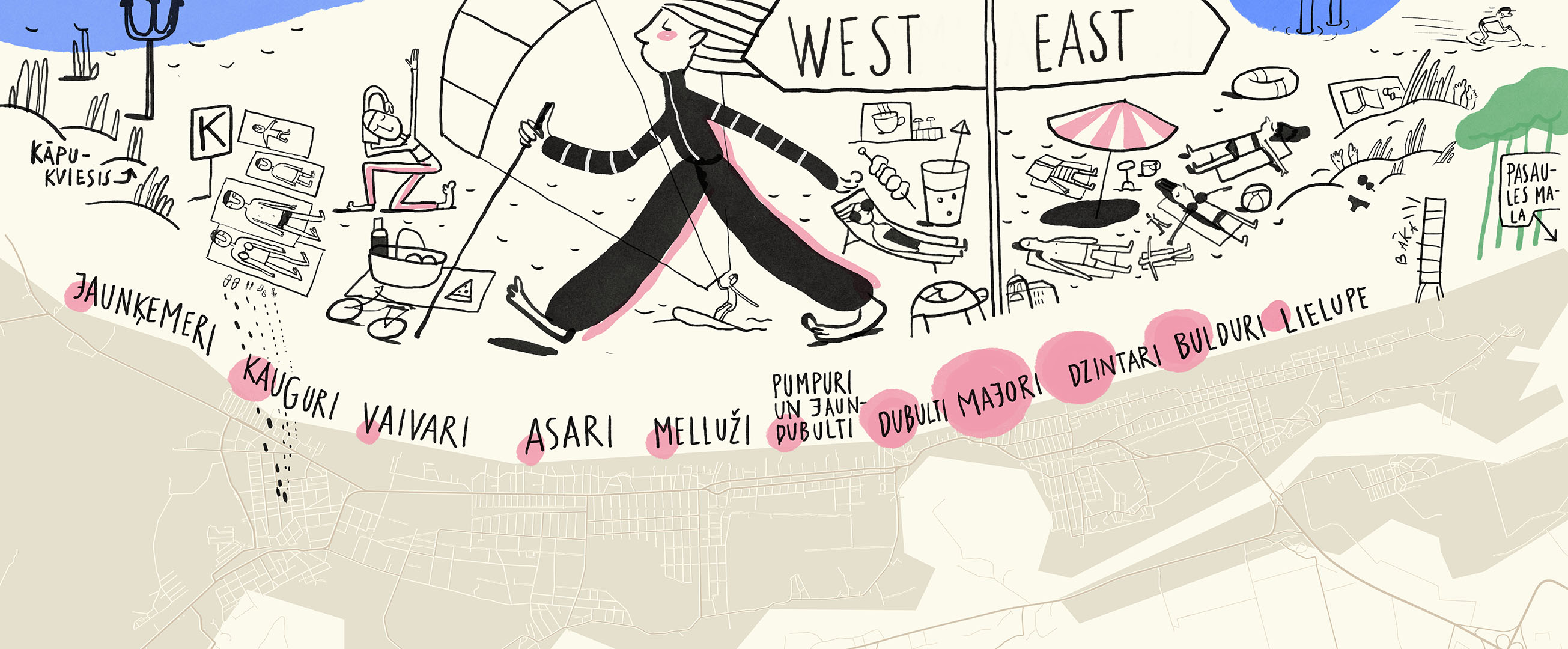
Jūrmala is the central 24-kilometre stretch of the Gulf of Riga coast, which is lapped by the calm, slightly salty (5-7 ppt) waves of the Baltic Sea. Dictated by the winds and the light, the colour of the sea changes from light brown to blue-grey and granite grey, while the beach is a constant golden shimmer of quartz sand. A forested dune coast runs almost the entire length of the beach, sheltered from wind blasts and washouts by willow groves. Although the coastal landscape may seem homogeneous at first, the character and atmosphere of the beach change every few hundred metres. This is mainly determined by the adjacent neighbourhoods – more than ten distinct areas of the city – and the distance from the centre of Jūrmala.
Just like authentic pearls, no two beaches are the same in the string along the Jūrmala coast. From utterly lively urban beaches, they transform into almost untouched wild seashores; they offer space for intense sporting activities as well as peaceful health-boosting activities, for socialising as well as contemplative solitude, for fine dining experiences in restaurants as well as simple picnics.
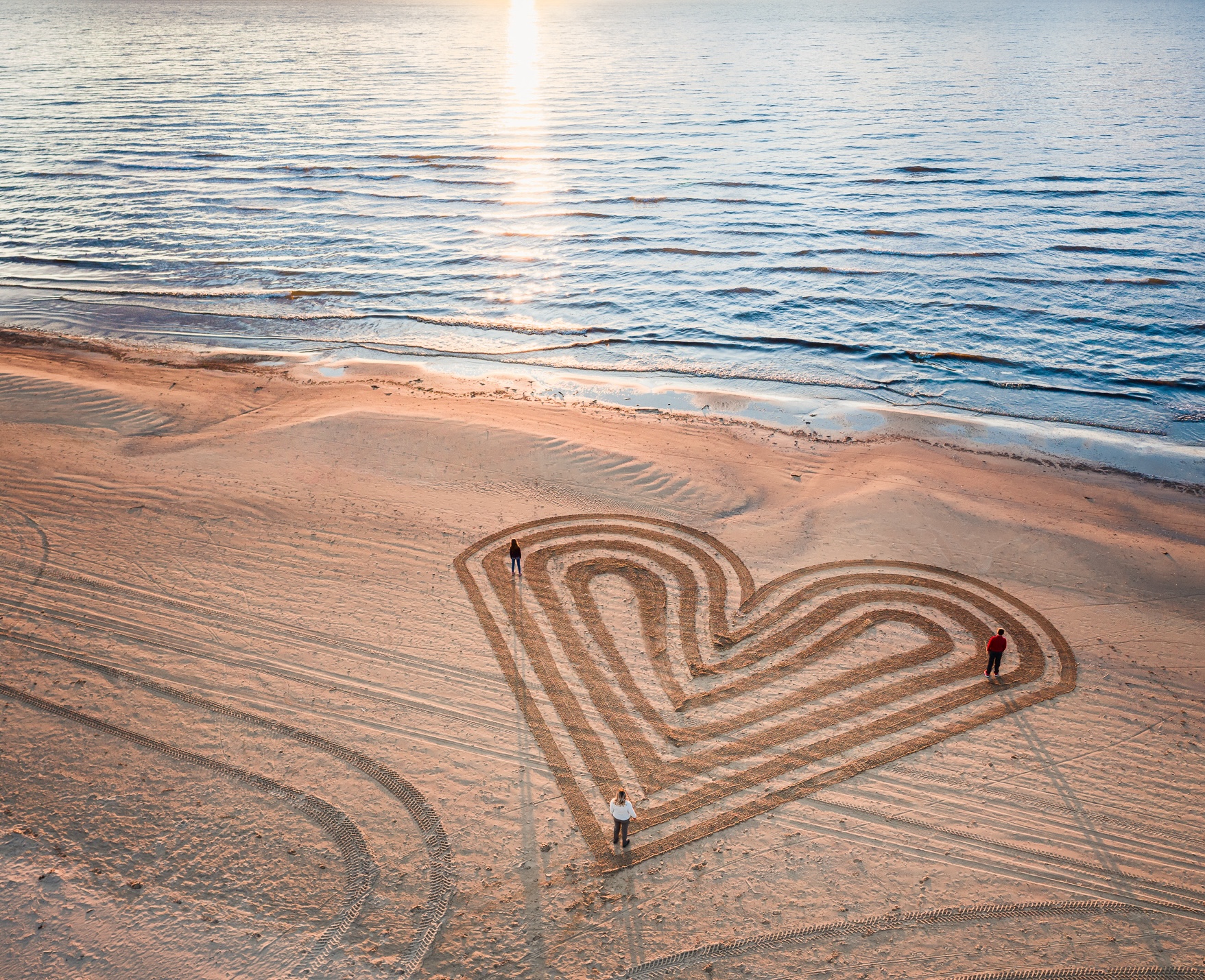
The Jūrmala coastline is regularly cleaned and aerated to prevent the accumulation of marine debris (such as seaweed and algae), ensuring that the flat beach is suitable for both pleasant barefoot walks and cycling. During the swimming season, water quality at the official Riga Gulf bathing sites is tested twice a month. The information displayed on the beach information boards indicates that, out of eleven official bathing sites in the Gulf, ten have excellent long-term water quality. Current information on temperature, weather conditions, sunrise, and sunset times is available on the Jūrmala Tourism Information Center’s website.
Beachgoers are encouraged to be responsible and to respect the rules of public order and hygiene to maintain the quality of the water. Please note that smoking, pets, overnight stays and camping are prohibited on the beaches.
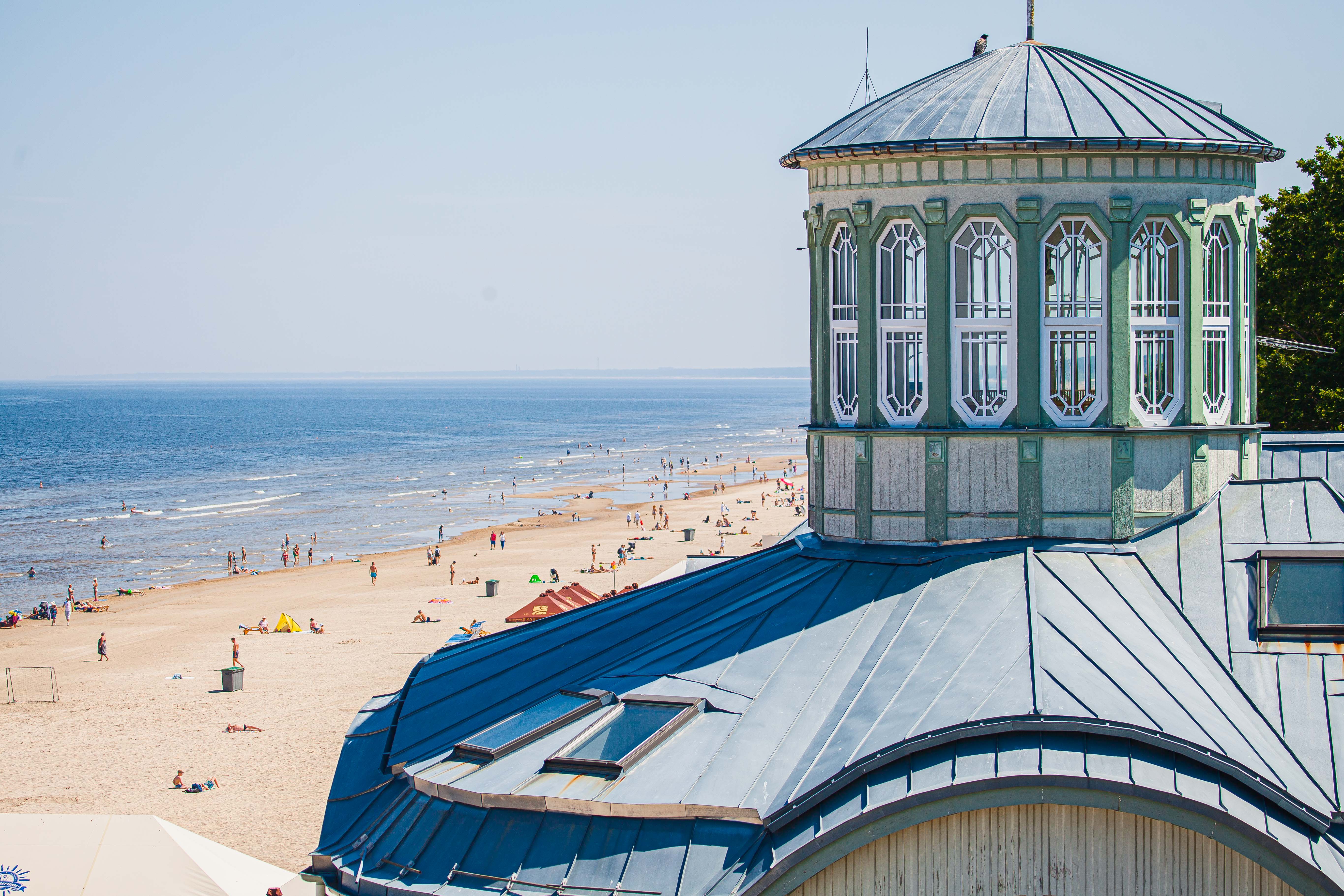
CITY’S CENTRAL BEACH
Majori Beach
Majori Beach – the central beach of Jūrmala. Like a pendulum, this beach will point you in the right direction, showing you whether you to want to stay in this lively epicentre or head east or west.
A series of quieter and noisier streets in the Majori area converge on the beach's white sands. It has historically been an important and popular beach for holidaymakers, as evidenced by several historic and architecturally significant buildings in the dune area, including those dating back to the years of beginning of the 19th/20th century spa resort.
On summer days, the number of holidaymakers looking for a place under the sun is quite high. On the beach, you can choose between rented beach chairs in carefully arranged seating areas, or simply laying out beach blankets in the area that seems most suitable. You don’t have to look far for refreshments and meals – they are available from the simplest seasonal cafés to all-season restaurants with well-considered menus.
The vibrant soundscape of music and rhythm coming from the cafés and the atmosphere of celebrating life on the Majori seafront continue until late in the evening. You can also enjoy the magic of the beach at night by taking a nearly kilometre-long walk along the illuminated beach promenade that stretches from Turaidas Street to Tirgoņu Street.
Where to eat and drink:
- During high season, the Baltic Beach Hotel & SPA also takes care of the well-being of Jūrmala guests right on the seashore, and the Beach Bar & Grill offers a street food menu and delicious cocktails in its comfortable couches.
- Summertime Café with great grilled food can be found in Majori Beach locations at the end of Teātra Street and at the end of Mālpils Street.
- The glass-roofed terrace house Simply Beach House (1 Pilsoņu Street) is open all season and offers great cocktails and a well-considered menu. And there's often a surprise near the café – a sand sculpture crafted with amazing care!
What to see nearby:
- The “Sea Pavilion” building at 1 Tirgoņu Street – an Art Nouveau building with a corner turret, once an important social centre.
- A two-storey wooden building with a high plinth on the beach side and carved details at 1 Pilsoņu Street – the former bathing establishment of Emīlija Rācene, which offered hot baths.
- The bronze sculpture “Turtle” at the end of Tirgoņu Street, symbolising longevity (by J. Bārda, 1995).
Useful information:
- Lifeguard station/outpost: yes.
- Wheelchair accessibility: concrete ramp at the end of Pilsoņu Street.
- WC: at the end of Kaiju Street and Viktorijas Street; in the lifeguard station building near Pilsoņu Street.
- Showers: at the end of Kaiju Street.
- Foot-washing taps: at the end of Viktorijas Street.
- Playgrounds: at the end of Pilsoņu Street.
- Sports facilities: beach sports centre The Beach Majori at the end of Kaiju Street – beach football, volleyball, tennis and handball courts.
- Water sports facilities: no.
- Active/quiet recreation zones: active – from Turaidas Street to Viktorijas Street; from Teātra Street to Ērgļu Street. Quiet – from Viktorijas Street to Teātra Street.
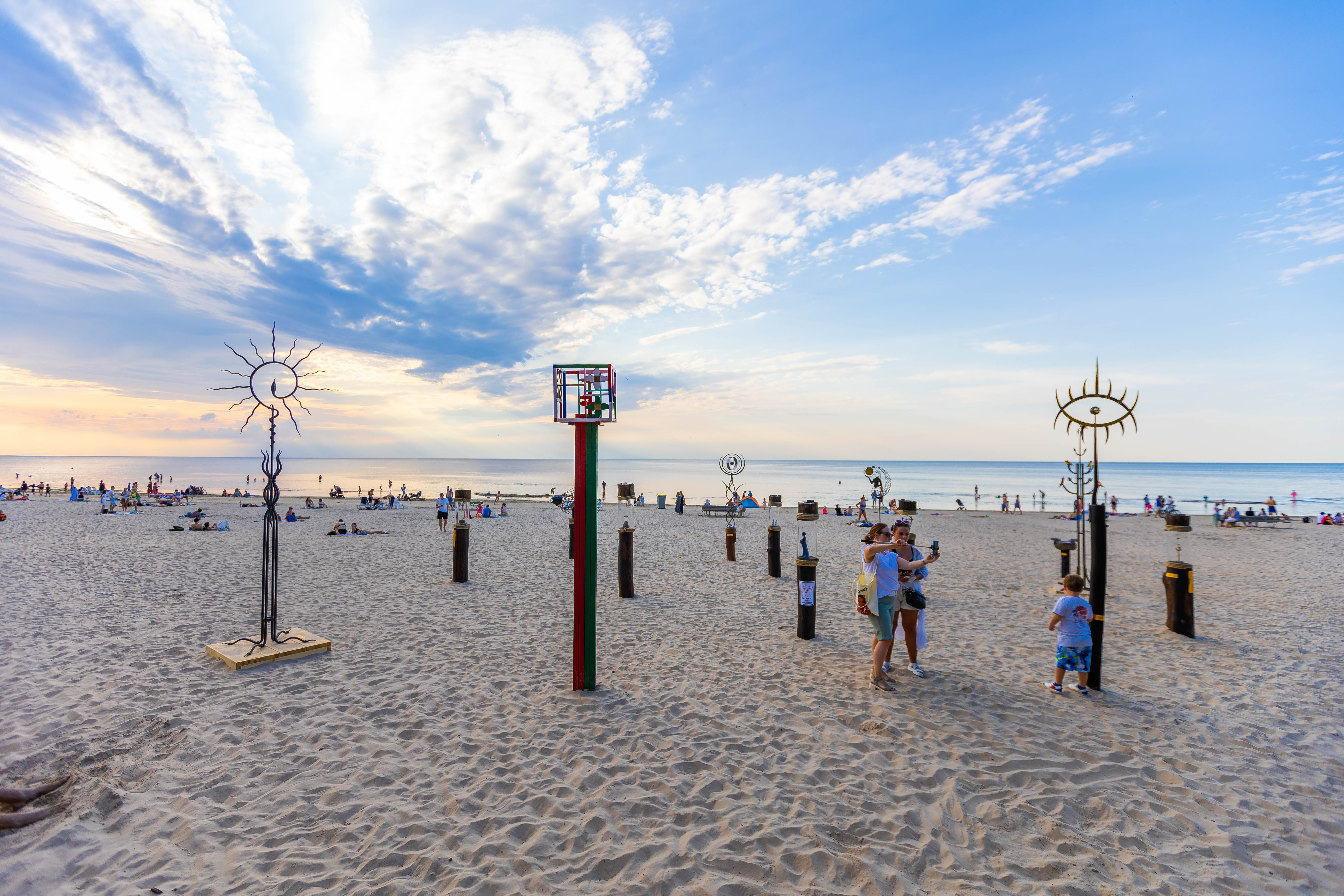
BEACHES TO THE EAST OF THE CITY
Dzintari Beach
Jūrmala's most prominent neighbourhood’s nearest beach, which has also become a special destination for culture lovers. Every year, during the Jūrmala Festival, the beach is enchanted by the "Sunrise Concert" from the principal organist of the Elbe Philharmonic, Iveta Apkalna, in the early summer morning hours, while at other times, the sounds of music from the nearby Dzintari Concert Hall echo along the beach. The Dzintari seashore also maintains the tradition of open-air exhibitions, during which environmental art objects – artefacts of the creative interaction between nature and human – are presented for the appreciation of beach visitors.
On hot summer days, the largest concentration of holidaymakers is found closer to the main 'gate' to the beach – at the end of Turaidas Street.
Where to eat and drink:
- Restaurant Light House Jūrmala (1a Gulbenes Street) is located in a ship-like hotel building right in the beach sand and offers a wide range of Mediterranean dishes, grilled seafood, vegetables and juicy meat dishes.
- Summertime beach café at the end of Drustu Street.
What to see nearby:
- Dzintari Concert Hall at 1 Turaidas Street is a building that combines in a symphonic interplay both facades made in the style of the 1930s Romanticism, and an open-air auditorium built in the 1960s. A significant stop on a tour of Latvian concert life.
Useful information:
- Lifeguard station/outpost: yes.
- Wheelchair accessibility: adapted ramp to the beach – at the end of Turaidas Street.
- WC: between Rūjienas and Lazdonas Streets; at the end of Drustu Street and Ainažu Street. At the end of Rūjienas Street, Drustu Street, and Kr. Barona Street.
- Showers: at the end of Rūjienas Street.
- Foot-washing taps: at the end of Turaidas Street and Drustu Street.
- Playgrounds: at the end of Drustu Street.
- Sports facilities: at the end of Gulbenes Street; exercise bars at the sea access point at the end of Mālpils Street.
- Water sports facilities: no.
- Active/quiet recreation zones: active – from Turaidas Street to Madonas Street. Quiet – from Madonas Street to Drustu Street.
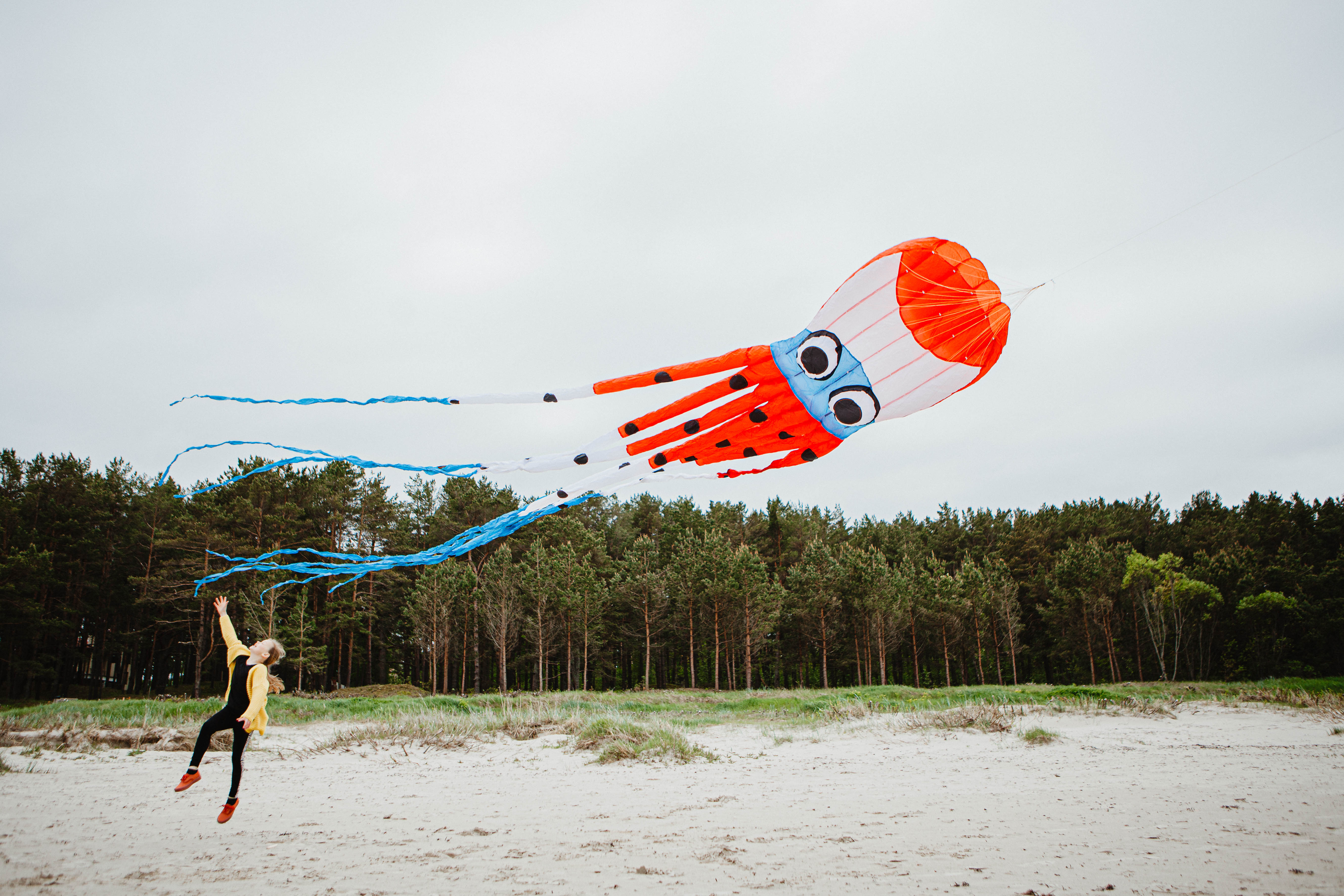
Bulduri Beach
On the hottest summer days, a mosaic of colourful towels materialises at Bulduri Beach, too, but there’s more space to relax. Children can play in the sand much more freely and patiently build sandcastles there. The beach café scene is also much sparser on the Bulduri Beach, but the flagship of beach gastronomy and relaxation is the Legend Beach Club (line 4). It features a beach restaurant, heated pools, beach bungalows, sofas and sunbathing chairs.
Where to eat and drink:
- Summertime beach café at the end of Vienības prospekts.
What to see nearby:
- Bulduri is considered to be the neighbourhood with the city's most splendid villas and mansions, but the beach is separated from the posh Jūrmala architecture of various ages by a vast area of forested dunes. If you want to experience both of these elements, you can go for a longer walk or cycle along the path, which runs tightly along the back of the luxurious mansions and winds through the dune forest towards the River Lielupe. The starting point of this route is near the environmental object “Baltic Stream” (by K. Līdums, 2022) – at the end of Vienības prospekts.
Useful information:
- Lifeguard station/outpost: yes.
- Wheelchair accessibility: adapted ramp to the beach – at the end of Vienības prospekts.
- WC: at the end of Vienības prospekts (adjusted for people in wheelchairs).
- Showers: at the end of Ainažu Street.
- Foot-washing taps: at the end of Vienības prospekts.
- Playgrounds: at the end of 6. līnija and Kr. Barona Street.
- Sports facilities: volleyball at 6. līnija, between 1. līnija and 2. līnija; between 8. līnija and 9. līnija.
- Water sports facilities: no.
- Active/quiet recreation zones: active – from 5th to 9th līnija. Quiet – from 5th to 2nd līnija.
Lielupe Beach
The almost untouched, wild, seashore-like beach of Lielupe is characterised by a pretty large sand rampart. Its shallow lowland offers a complete shelter if only you can tolerate its sharp sand and robust grasses.
The beach dune zone is formed by the unspoilt area of the Ragakāpa Nature Park. In front of it, like sheer curtains waving in the breeze, is a solid stand of young, slender pine trees, and behind them – a succulent pine forest. Here, planes can be seen from a distance as they make a sweeping arc over the bay to land at the Riga Airport. This aerial scene is the only reminder of the proximity to civilisation; the silence on the beach is almost deafening.
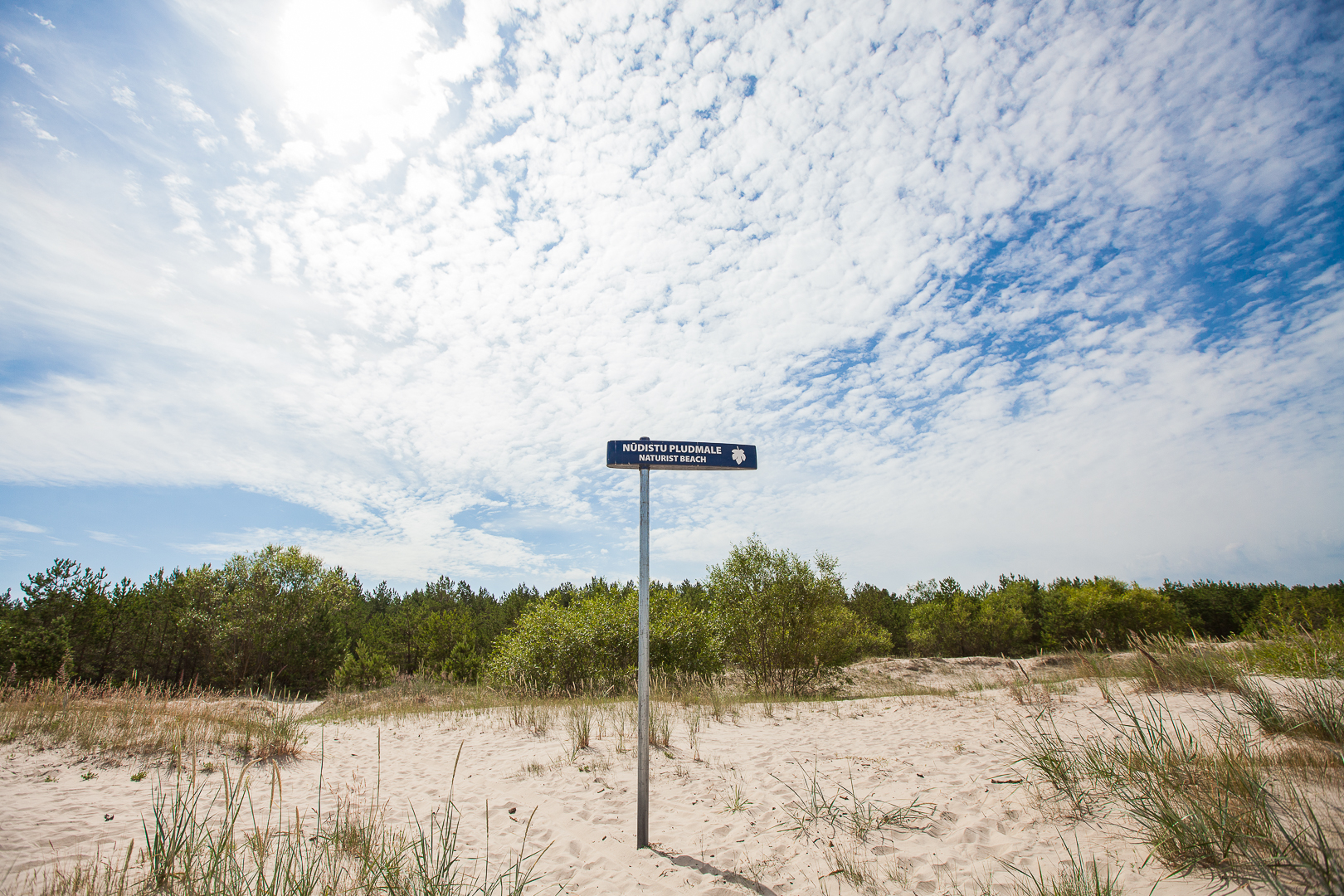
Beach at the Lielupe Estuary
The beach, where the river greets the sea, resembles an endless desert of sand – it is not without reason that the 300-metre-long beach and the vast area of bare dunes have been nicknamed “the edge of the world” (pasaules mala) by the locals. Here you can enjoy deep peace and silence, if not interrupted by the frequent presence of jet ski enthusiasts.
This part of the Lielupe Beach is also popular among the adherents of nudist culture and has been since the times of the Tsar. So don't be surprised if you spot a free-spirited naked body on a small stretch of beach against a backdrop of wind-blown dunes.
Where to eat and drink:
- There are no cafés on the beach, but you can grab something to eat and drink at the Food Truck 36 Line caravan, founded by Michelin-starred chef from Jūrmala Lauris Aleksejevs, located just outside the car park at the end of 36. līnija.
What to see nearby:
- The Lielupe Beach in the dune zone is overlooked by the Buļļuciems Lighthouse – the only lighthouse in Jūrmala. Its 28-metre-tall tower with red and white plank cladding is visible from anywhere on the seashore.
- You can enjoy the primordiality of the River Lielupe in Ragakāpa Nature Park, an 800 m long and 100 m wide forested sand hill - one of the highest dunes (12-17 m) in Latvia. Here you can expect to encounter rare, protected plants and, if you're lucky, fearless roe deer.
Useful information:
- The beach at the estuary of the River Lielupe can be reached by car along Vikingu Street, then on foot along Tīklu Street and through the forest.
- Lifeguard station/outpost: no.
- Wheelchair accessibility: adapted ramp to the beach – at the end of 36. līnija.
- WC: at the end of P. Stradiņa Street.
- Showers: no.
- Foot-washing taps: no.
- Playgrounds: at the end of 36. līnija; between 13. līnija and 14. līnija.
- Sports facilities: volleyball at 6. līnija, between 1. līnija and 2. līnija; between 8. līnija and 9. līnija. Fitness equipment – at the end of 36. līnija.
- Water sports facilities: kiteboarding, windsurfing are allowed from the border of the Lielupe bathing place towards the Lielupe estuary 600 m to the east. Possibility to deliver a jet ski – at the end of 36. līnija.
- Active/quiet recreation zones: active – from 36th līnija, 700 meters towards the inlet. Quiet – from 36th to 33rd līnija.
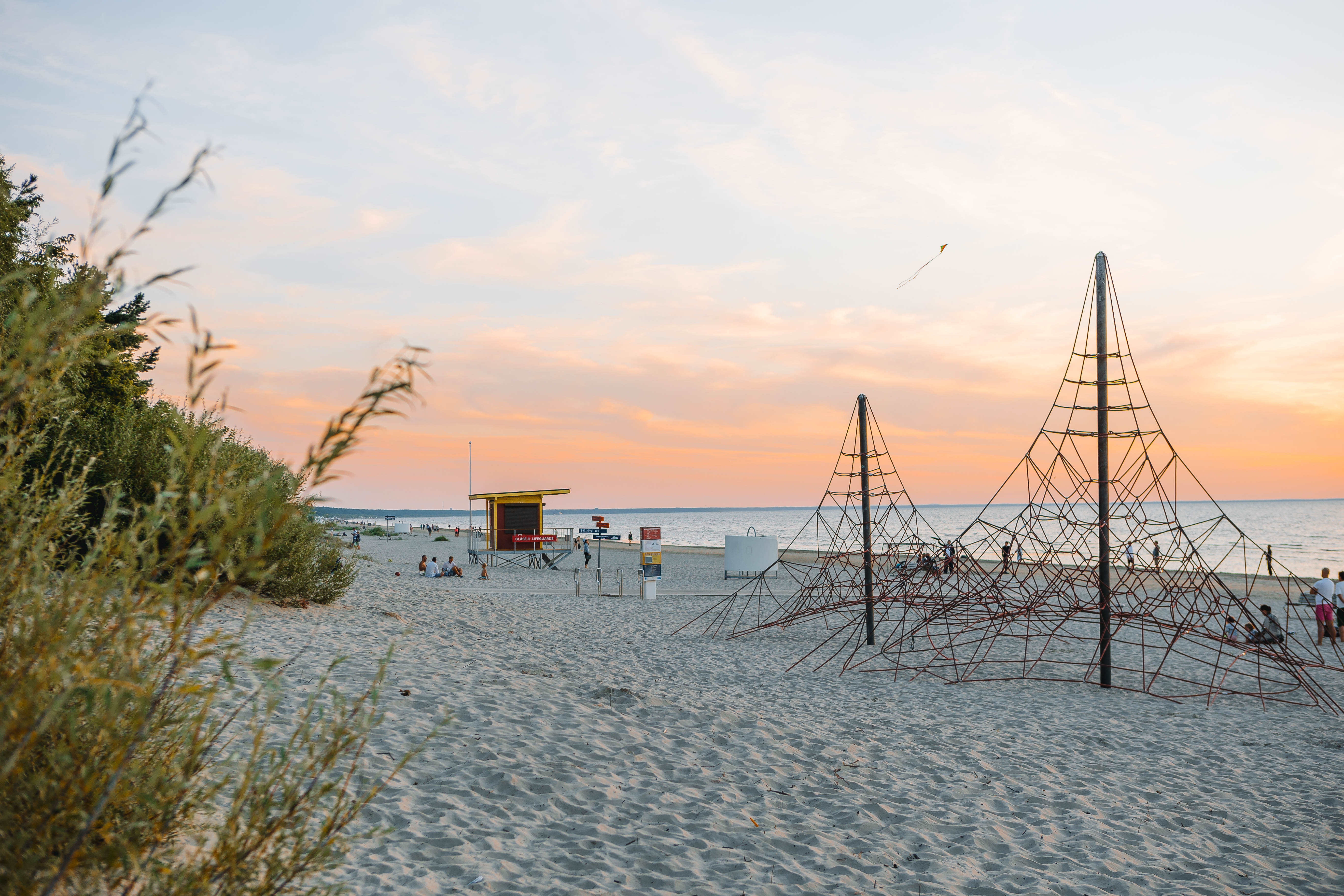
BEACHES TO THE WEST OF THE CITY
Dubulti Beach
The next in the string of beach pearls, located to the west of central Majori Beach, is Dubulti Beach. Still lively enough, the beach guests themselves are those creating the major bustle by engaging in various outdoor activities. Where Baznīcas Street meets the beach, the active area is marked on both sides of the wooden boardwalk, but jet skis break the waves.
You will find a more distant beach experience heading towards Jaundubulti.
Where to eat and drink:
- Dubulti Beach has now become a special gastronomic destination – some people go there for a restorative meal at the Caucasian restaurant Kinza House (2/3 Baznīcas Street), others – for an exquisite gastronomic experience at the restaurant 36. Line Grill Restaurant (2b Baznīcas Street), rated by the prestigious Michelin Guide.
What to see nearby:
- The sculpture “Aspazija in Dunes” (by O. Šilova, 2020) at the end of Aspazijas Street is dedicated to the great Latvian poet Aspazija and is located near the house where she spent the last ten years of her life.
- Remnants of the former sanatorium “Marienbāde” will remind you of the past glory of the golden times of the resort town, as well as the stubbornness with which the deepest building on the beach was able to withstand the sea winds (41/43 Z. Meierovica prospekts).
Useful information:
- Lifeguard station/outpost: no.
- Wheelchair accessibility: adapted ramp to the beach – at the end of Kļavu Street.
- WC: at the end of Kļavu Street (adjusted also to persons in wheelchairs).
- Showers: no.
- Foot-washing taps: at the end of Kļavu Street.
- Playgrounds: at the beach access points at Parka, Baznīcas, and Kļavu Streets.
- Sports facilities: volleyball – between Baznīcas and Parka Streets; at the end of Ogres Street.
- Water sports facilities: jet ski rental is available – at the end of Kļavu Street.
- Active/quiet recreation zones: active – from Baznīcas Street to Ogres Street. Quiet – from Parka Street to Baznīcas Street.
Jaundubulti and Pumpuri Beaches
Jaundubulti and Pumpuri Beaches are definitely destinations for lovers of peaceful relaxation. Often only local holidaymakers can be seen on the beaches, but there are also seasonal cafés for a light meal or refreshments. These are also excellent beach choices for those who want to combine lazy sun and sea bathing with health-boosting walks in the dunes.
What to see nearby:
- The wooded strip of dunes stretching along Jaundubulti and Pumpuri is an excellent place for a forest walk. In the territory of Jaundubulti, the dune is bushier, while in Pumpuri it is a pure pine forest with a soft carpet of moss. The “Labsajūtas dabas taka” (Wellbeing nature trail) has been created here. It stretches for about 2 km (from Baznīcas Street to Amatas Street) for relaxation, exploration and physical activities. Pedestrians and Nordic walkers, and hardened joggers alike can enjoy the varied terrain of this seaside dune along conifer and cone-paved paths.
- The sculpture “Rainis’ Pines” (by K. Gulbis, 2014) near Amata Street – installed at the favourite quiet spot where the poet Rainis liked to rest, to which he dedicated his poem “Broken Pines”, and which symbolically perpetuates memories and testimony about the time, place and its events.
Useful information:
- Lifeguard station/outpost: no.
- Wheelchair accessibility: adapted ramp to the beach; special changing cubicles; adapted WC at the end of Līgatnes Street (Jaundubulti).
- WC: at the end of Līgatnes Street (Jaundubulti).
- Showers: no.
- Foot-washing taps: no.
- Playgrounds: at the end of Salaca Street (Pumpuri).
- Sports facilities: at the sea access point at the end of Braslas Street (Jaundubulti).
- Water sports facilities: kiteboarding and windsurfing are allowed from Upes Street to Gundegas Street (Pumpuri).
- Active/quiet recreation zones: active – from Iecavas Street to Gundegas Street (Pumpuri). Quiet – from Salacas Street to Iecavas Street (Pumpuri).
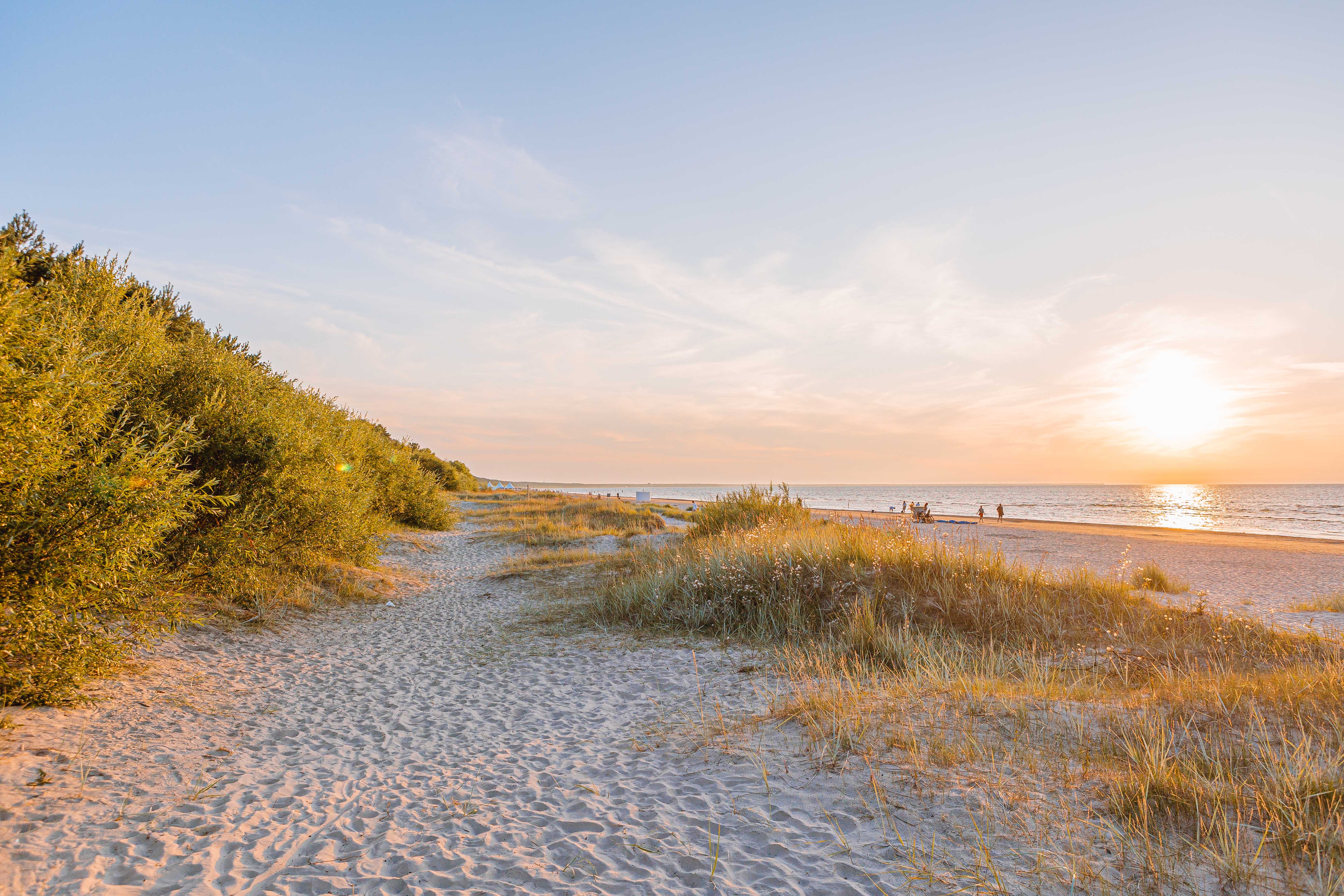
Melluži and Asari beaches
These beaches are reached by those who are convinced they want to enjoy the beach on their own. Often, you won't see a living soul for 100 metres, except near the seasonal cafés. Marked in the beach landscape next to the green dune forest line is a prominent belt of willow trees, which turns reddish in autumn.
The Melluži and Asari dunes are also walkable along narrow paths, crossed here and there by a narrow pool of water, which also dries in the white sand – without meeting the waters of the big sea.
Where to eat and drink:
- The Stories beach café in Melluži (between Dārzu and Krūmu Streets) offers not only food and refreshments but also a wide programme of events and activities.
What to see nearby:
- In the area of the Asari headland – at 85 Kāpu Street – there is a small, old cemetery with Art Nouveau tombstones and ornately wrought crosses and fences.
- The neighbourhoods of Melluži, Asari and Vaivari are connected by Kāpu Street, which boasts of splendid mansions and summer cottages, some of which are included in the list of cultural heritage buildings and others in the list of notable buildings.
Useful information:
- Lifeguard station/post: yes (Melluži).
- Wheelchair accessibility: adapted ramp to the beach –at the end of Dzimtenes Street (Asari).
- WC: at the end of Upes Street, Dārzu Street, Rožu Street (Melluži); at the end of Dzimtenes Street (Asari).
- Showers: at the end of Dzimtenes Street (Asari).
- Foot-washing taps at the end of Rožu Street, Dārzu Street, and Upes Street (Melluži).
- Playgrounds: at the end of Puķu Street; at the end of Rožu Street (Melluži); at the end of Dzimtenes Street (Asari).
- Sports facilities: volleyball in Melluži – between Upes and Peldu Streets; between Rožu and Magoņu Streets. Volleyball in Asari – from Zaru Street to Dzimtenes Street; between Rūsiņa and Birzes Streets. Fitness equipment – at the end of Rožu Street (Melluži); at the end of Dzimtenes Street (Asari).
- Water sports facilities: kiteboarding, and windsurfing are allowed in Asari (600 m east from the border of the Asari swimming area). Jet ski rental available – at the end of Dzimtenes Street (Asari).
- Active/quiet recreation zones: active – 700 meters west of Dzimtenes Street (Asari). Quiet – 100 meters east of Dzimtenes Street (Asari).
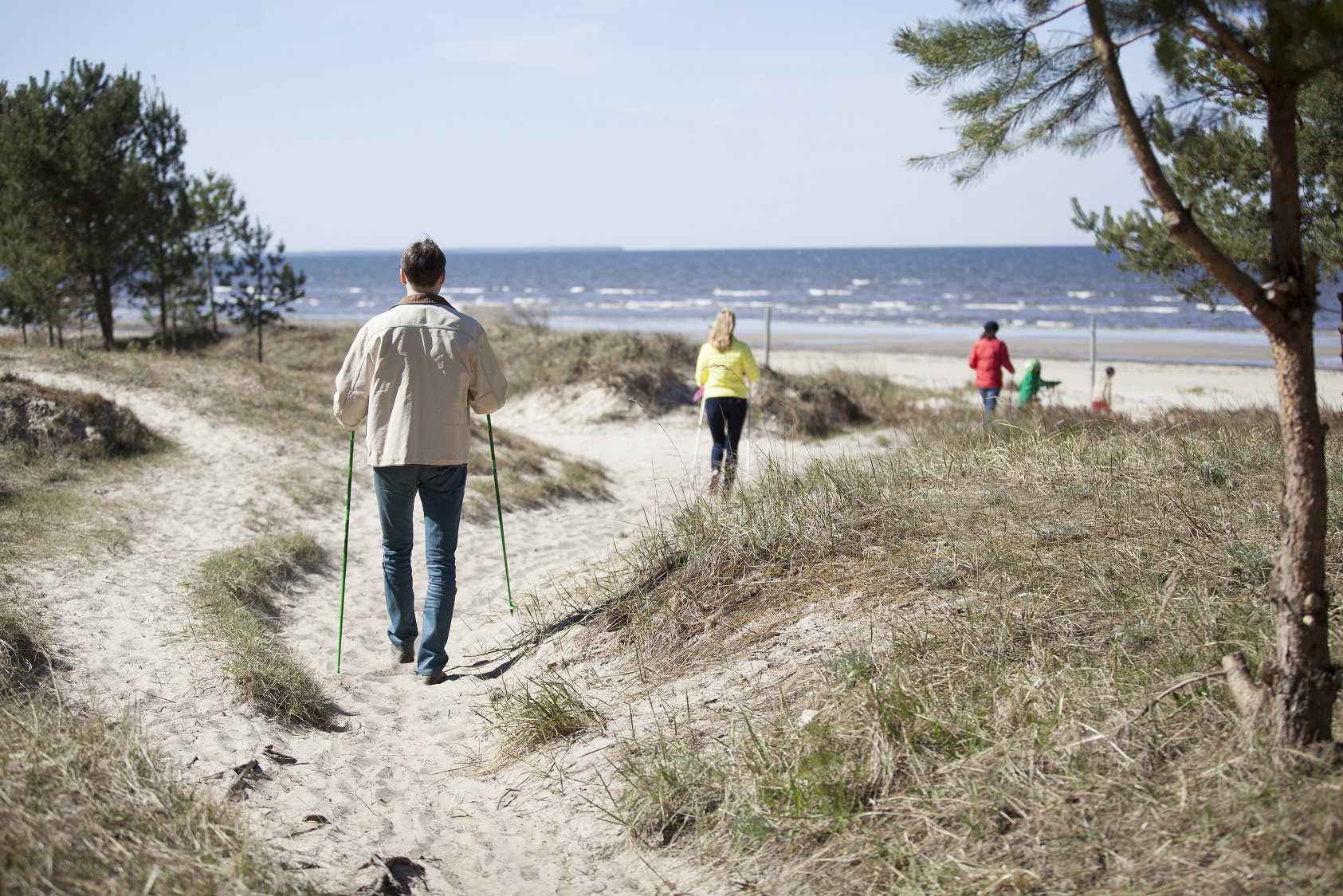
Vaivari Beach
The character of Vaivari Beach is determined by its proximity to the Vaivari National Rehabilitation Centre. Yoga and Nordic walking classes are often held here. This is where long walks and cycling are most often started or finished.
Where to eat and drink:
- There are no seasonal cafés on the Vaivari Beach, but since the opening of Stacija Vaivari Pizza (15 Laimdotas Street) in the historic Vaivari Station (15 min walk), the beach has become a picnic spot for takeaway pizza and other delicacies.
Near the beach:
- The masonry building, uncharacteristic for Jūrmala and located at 153/155 Kāpu Street, is a local architectural monument, historically built for a girls' boarding school. Constructed from split fieldstones, it is a massive example of historicist architecture, with lightness added by the attached wooden verandas. The driveway from both sides gives it a manor-like impression.
Useful information:
- Rescue station/post: no.
- Wheelchair accessibility: adapted ramp to the beach; special changing cubicles; adapted WC at the end of Vēju Street.
- WC: at Atbalss Street; at the end of Vēju Street.
- Shower: no.
- Foot-washing facilities: at the end of Vēju Street.
- Playgrounds: at the end of Vēju Street.
- Sports facilities: volleyball – from Zaru Street to Dzimtenes Street; between Rūsiņa and Birzes Streets. Fitness equipment at the Vaivari campsite (Atbalss Street 1).
- Water sports facilities: no.
- Active/quiet recreation zones: active – 300 meters west of Vēju Street. Quiet – 100 meters east of Vēju Street.
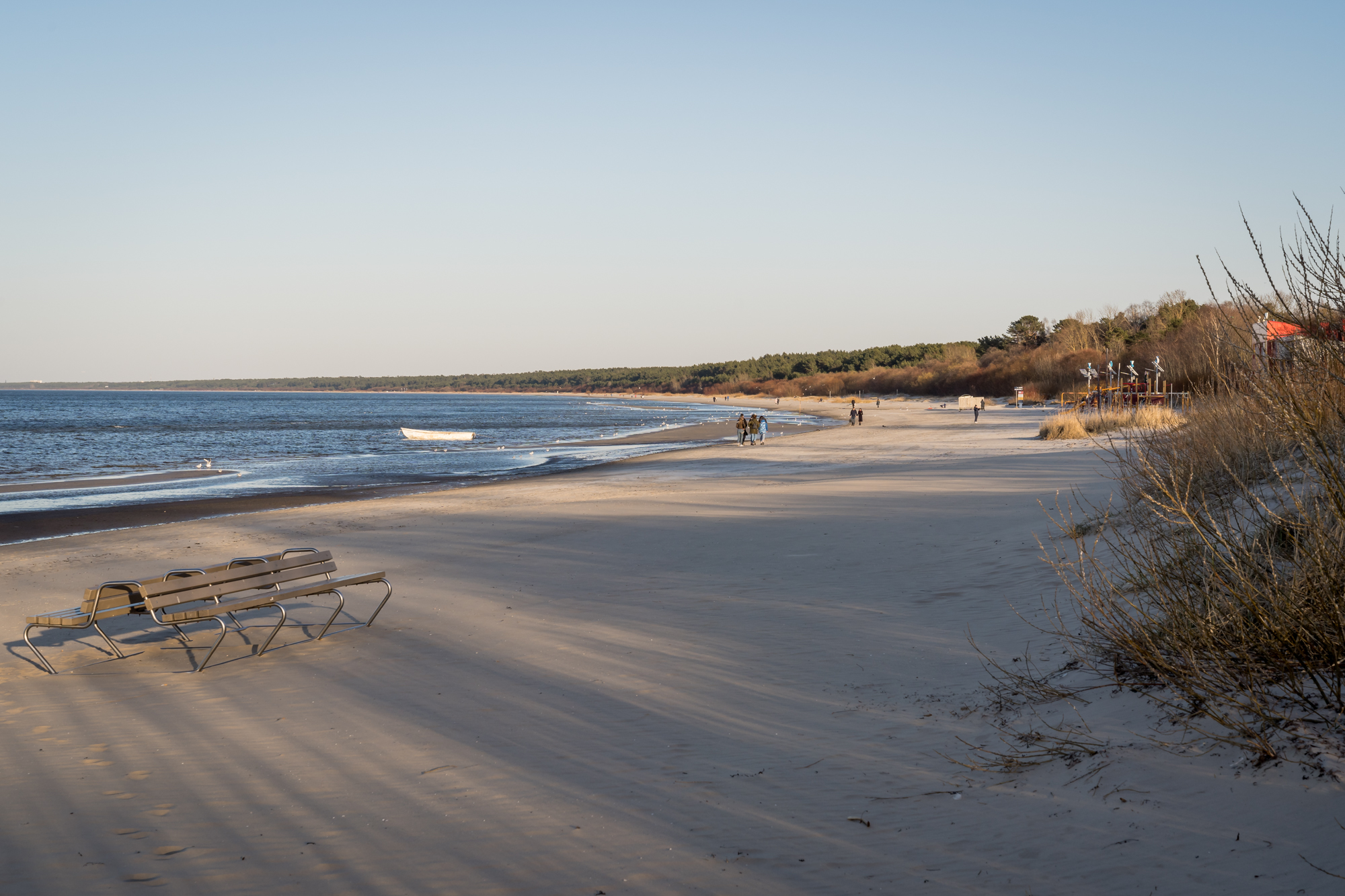
Kauguri Beach
The Kauguri Beach is an absolute 'republic' of locals. This is determined by the adjacent Kauguri district, where most of the city's permanent residents live. This stretch of beach also has no forested dune, replaced by a development of mansions. This is the old Kaugurciems – a former fishermen’s village. Rare evidence of said village can be seen from old, slanting wooden houses to rotten boats in the yards.
Where to eat and drink:
- One of these, partly staged, fishermen's homesteads is the Kūriņš café (47 Kaugurciema Street) - an institution with a history that will inevitably leave you feeling satisfied with its decent food offer.
Useful information:
- Rescue station/post: yes.
- Wheelchair accessibility: adapted ramp to the beach; special changing cubicles; float bikes, tricycles and tandem bikes at the lifesaving station (tel.: +371 29103212 (for Jūrmala residents only!)); adapted WC – at the end of Kapteiņa Zolta Street.
- WC: at the end of Draudzības Street.
- Showers: at Draudzības Street.
- Foot-washers: at the end of Kapteiņa Zolta Street.
- Playgrounds: at the end of Kapteiņa Zolta Street and Zvārtas Street; from Vēžu Street to Glūdas Street.
- Sports facilities: parallel bars, pull-up bars, and fitness equipment: at the sea access point at the end of Kapteiņa Zolta Street.
- Water sports facilities: kiteboarding, and windsurfing are allowed from Brekšu Street 600 m westwards. Jet ski rental possible – at the end of Kapteiņa Zolta Street.
- Active/quiet recreation zones: active – 900 meters west of Kapteiņa Zolta Street. Quiet – 300 meters east of Kapteiņa Zolta Street.
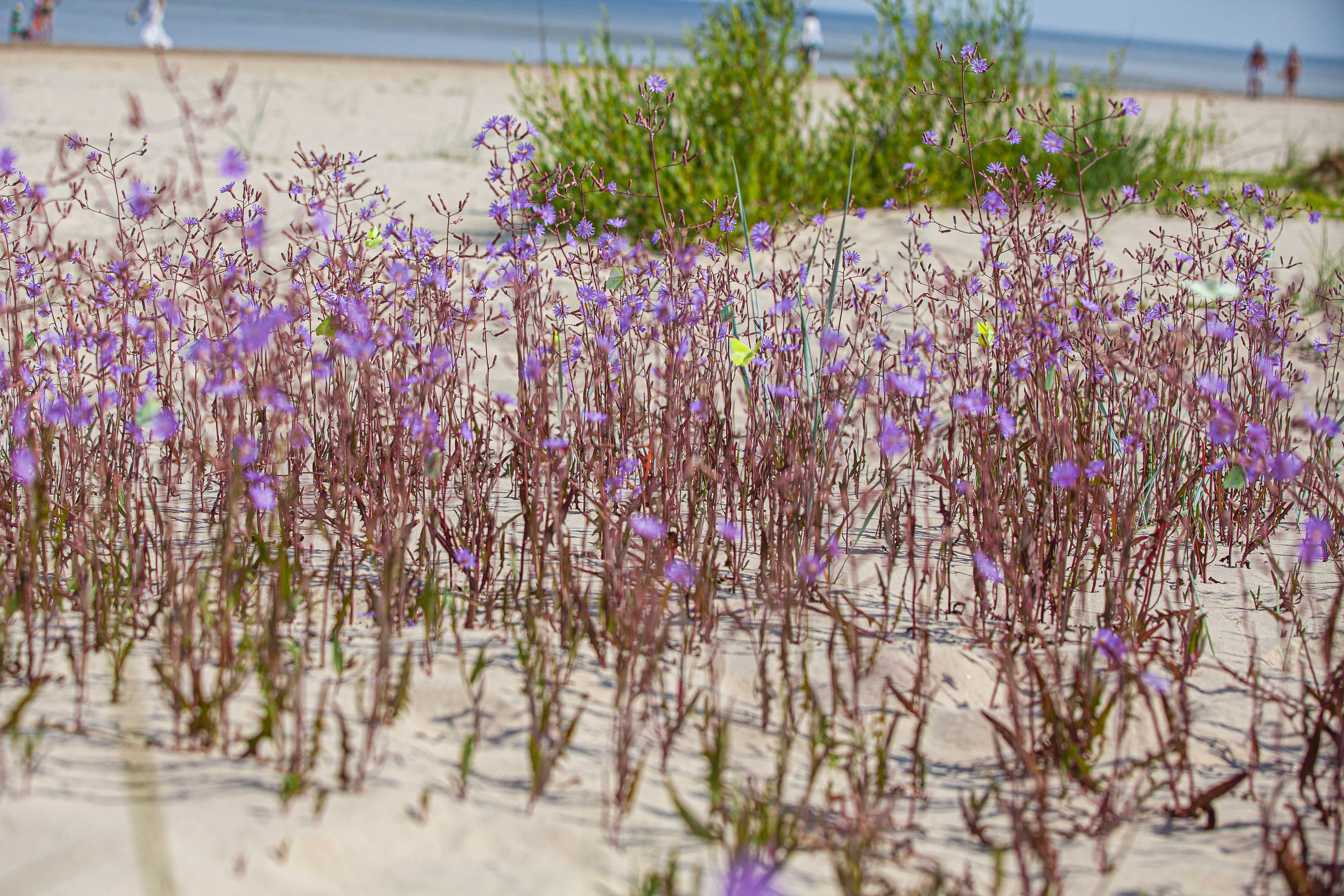
Jaunķemeri Beach
This is already a beach where the white sand strip narrows considerably. Unlike the deserted, man-stamped beaches, here nature is cyclically given a chance to recover – for plants and bentgrass to renew, which is why the beach is dotted with Honckenya peploides or lyme-grass spit almost to the water's edge.
Where to eat and drink:
The Neptūns restaurant (1 Jaunķemeru ceļš) is an almost self-sufficient destination in the vicinity of the beach. It was here where the end station of the Ķemeri-Jaunķemeri tram line opened in 1912 was located, near which a restaurant was built in 1968, which continues its activity to this day and is therefore considered to be the oldest restaurant in Jūrmala. Its menu mixes a wide variety of cuisines, and its surroundings are 'overlooked' by sculptural representations of the sea god Neptune.
Useful information:
- Rescue station/post: no.
- Wheelchair accessibility: adapted ramp to the beach; special changing cubicles; adapted WC – Brīzes Street. Adjusted ramp to the beach – Jaunķemeru ceļš.
- WC: at the end of Brīzes Street.
- Showers: no.
- Foot-washers: at the end of Brīzes Street.
- Playgrounds: at the end of Brīzes Street.
- Sports facilities: no
- Water sports facilities: jet ski rental possible – end of Jaunķemeru ceļš.